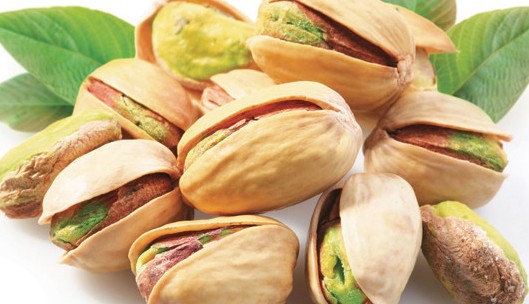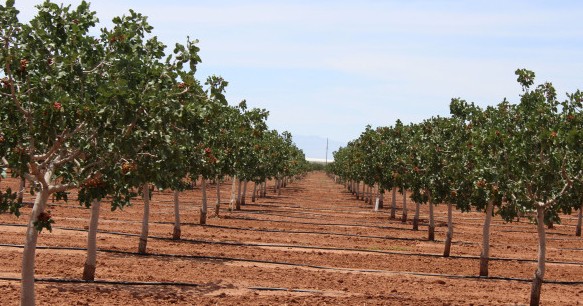Pistachio Cultivation Guide:

Introduction of Pistachio Cultivation:- Pistachios are grown for its edible nuts and pistachio tree is a small to medium sized tree with a branching main stem and a spreading growth habit. It can reach up to 20 feet height in wild conditions and up to 10 feet in cultivated conditions. Pistachio is one of the culinary nuts grown in most of the countries and belongs to the cashew family. These nuts are the lowest calorie of the nuts, but they are rich in phytosterols, antioxidants, unsaturated fat, carotenoids, vitamins and minerals and fiber. It is uncertain where pistachio nut trees originated but probably originated from Middle East and Central Asia. Pistachios belong to the family of “Anacardiaceae and genus of “Pistacia”. Basically pistachio trees are either male or female. However, both are required to produce a crop. Usually the nuts are produced on the female trees where as male trees provide the pollen to fertilize the female tree flowers. Pistachio trees take longer time to get into production stage. Pistachio nuts have excellent demand both locally and internationally. One can obtain decent profits if they are grown in right climate by following good pistachio farming practices.
Health Benefits of Pistachio Nuts:- The following are some of the health benefits of Pistachio nuts.

- Pistachios are heart friendly nuts.
- Pistachios are good source of vitamins and minerals.
- Pistachios are low calorie nuts, hence aids in weight management.
- Pistachios help in reducing the risk of age related macular disease.
- Pistachios help in eliminating skin dryness.
- Pistachios are good source of dietary fiber and aids in digestion.
- Pistachios have Aphrodisiac and Antioxidant properties.
- Pistachios protects from getting diabetes.
- Pistachios help in absorption of iron from food.
- Pistachios help in decreasing the LDL (bad cholesterol) level in blood.
Pistachio Varieties in India:- Kerman, Peter, Chiko, Red Allepo and Joley are some of the varieties grown in Jammu & Kashmir region.
Local Names of Pistachio in India:- Pista (Hindi, Gujarati, Punjabi, Telugu, Kannada, Marathi, Oriya, Assamese, Bengali), பசுங்கொட்டை (Tamil), പീസത (Malayalam).
Climate Required for Pistachio Cultivation:- Weather condition is most important factor in growing pistachio crop. These nut trees prefer day temperatures above 36 °C and winter months cold enough to complete their dormant period 7 °C. These trees don’t grow well in high elevations due to the cool temperatures. In India, Jammu & Kashmir is natural location to grow pistachio nuts.
Soil Requirement for Pistachio Cultivation:- Pistachio tress can be grown in wide range of soils. However, they prefer well-drained deep sandy loam soils. These trees are quite drought tolerant but don’t do well in areas where high humidity is possible. Soil test would be helpful, if you are planning pistachio production on large scale. Pistachio trees will produce quality nuts with high yields where soil pH is kept at a range of 7.0 to 7.8. These trees are hardy ones which can tolerate higher alkalinity to certain extent.
Land Preparation in Pistachio Cultivation:- When it comes to preparing the land in pistachio cultivation, the process should be similar to other nut crops. Soil should be chiselled, ploughed and disked to obtain the soil fine tilth stage. If any hardpan is found in the top 6 to 7 feet of soil, it should be broken as pistachio trees are deep rooted in nature and these trees are affected by water stagnation.
Propagation in Pistachio Cultivation:- Pistachio trees are usually propagated by budding on to a suitable pistachio rootstock. These rootstock (seedlings) can be raised in nurseries. Usually, budding is carried out in fall with and the budded trees are being planted the same year or the following year depending on the size of the rootstock (seedling).

Planting and Spacing in Pistachio Cultivation:- As part of the planting, dig the holes large enough to accommodate the roots. Generally, the Pistachio trees should be planted 1 inch lower than it was raised in nurseries or containers. When it comes to plant spacing, it depends on irrigation. In case of irrigated gardens, plants should be spaced at 6 meter × 6 meter for grid pattern. In areas where irrigation is not available, trees can be spaced at 8 meter × 10 meter. For bearing Pistachio nuts, both male and female trees should be planted in the ratio of 1:8 (one male and eight female trees) to 1:10 (one male and ten female trees).
Irrigation in Pistachio Cultivation:- Though Pistachio tress are draught tolerant, they should be maintained with enough moisture whenever needed. Mulching is the best practice to retain the water. Drip irrigation can be adopted for proper utilization of water. Avoid any water logging conditions. Rainy season don’t need any irrigation.

Manures and Fertilizers in Pistachio Cultivation:- As nitrogen is important fertilizer for any nut crop, pistachios trees have a similar nitrogen requirement just like other nut trees. However, fertilizers should not be applied in the first year of planting but in the subsequent year. Each pistachio tree should be provided with 450 grams of ammonium sulphate in 2 split doses during the growing season. In later years, actual nitrogen (N) of 45 kg to 65 kg per acre should be provided. Nitrogen should be applied in 2 splits doses over the growing season.
Intercultural Operations in Pistachio Cultivation:- Pistachio trees should be trained to grow upward and outward direction and develop into a modified open-vase shape. The center of the tree should be kept open to admit sunlight for better flower formation and fruit set, which might be needed by the 4th or 5th winter season. Secondary branches should be removed as part of thinning operation. Once the tree framework has been established, only minor pruning cuts should be needed. Weed control is another task in pistachio production for healthy growing of trees and producing quality nuts. Make sure to clean the space between trees as the weeds compete for nutrients. Herbicide treatments should be mainly used for the berms and are applied pre-emergent and/or post-emergent. Mulching the trees controls weeds as well as retains the water content in the soil.
Pests and Diseases in Pistachio Cultivation:- Mites, Stinkbug and Leaf-footed plant bug are the common insect pests found in Pistachio production. Powdery mildew, Rust, Alternaria late blight, Armillaria root rot, Crown gall, Pistachio dieback, Septoria leaf spot, Panicle and shoot blight, Pistachio psyllid and Pistachio twig borer are some of the diseases found in pistachio cultivation. For symptoms and control measures, contact your local horticulture
Note: Contact your local department of horticulture for pests and disease symptoms and their control. They are the best source for control solutions in pistachio cultivation.
Harvest in Pistachio Cultivation:- Pistachio trees take longer time to produce nuts. These budded trees become ready to produce fruits for 5 years and will not reach maximum production until the 12th year of planting. ( Pistachio trees begin bearing the 5th year after budding. However, a significant crop is not harvested until the seventh or eighth season. The first full production year starts occurring around 12th year only). The easy identification of maturity is when the hull separates easily from the shell. Generally, this period extends for 6 to 10 days. Care should be taken while harvesting by avoiding underdeveloped kernels.
Yield in Pistachio Cultivation:- Yield of the Pistachio nuts mainly depends on climate , cultivar (variety) and crop management practices. On an average a yield of 8 to 10 kg per fully matured tree (After 10 to 12 year of budding) can be obtained.
For Asia Farming Guide : Read here.
For Sheep or Goat Farming Business: Read year.
where can I buy seeds for planting?
you may try for the seedlings at nurserylive dot com.
Where do I get seeds of Pistachio in India?
Can Pistachio Trees Be Grown In Gujarat In Greenhouse?
Can these grown in Andhrapradesh ?
From where to buy male and female grafted Pista plants.
Nurseries are selling only one plant. Is that fake?
Pistachio grafted plants are not available in India. One has to import them from producing countries.
I am also working on this project, right now searching for a suitable land of around 40 acres to start with.
Have u found the plants ?